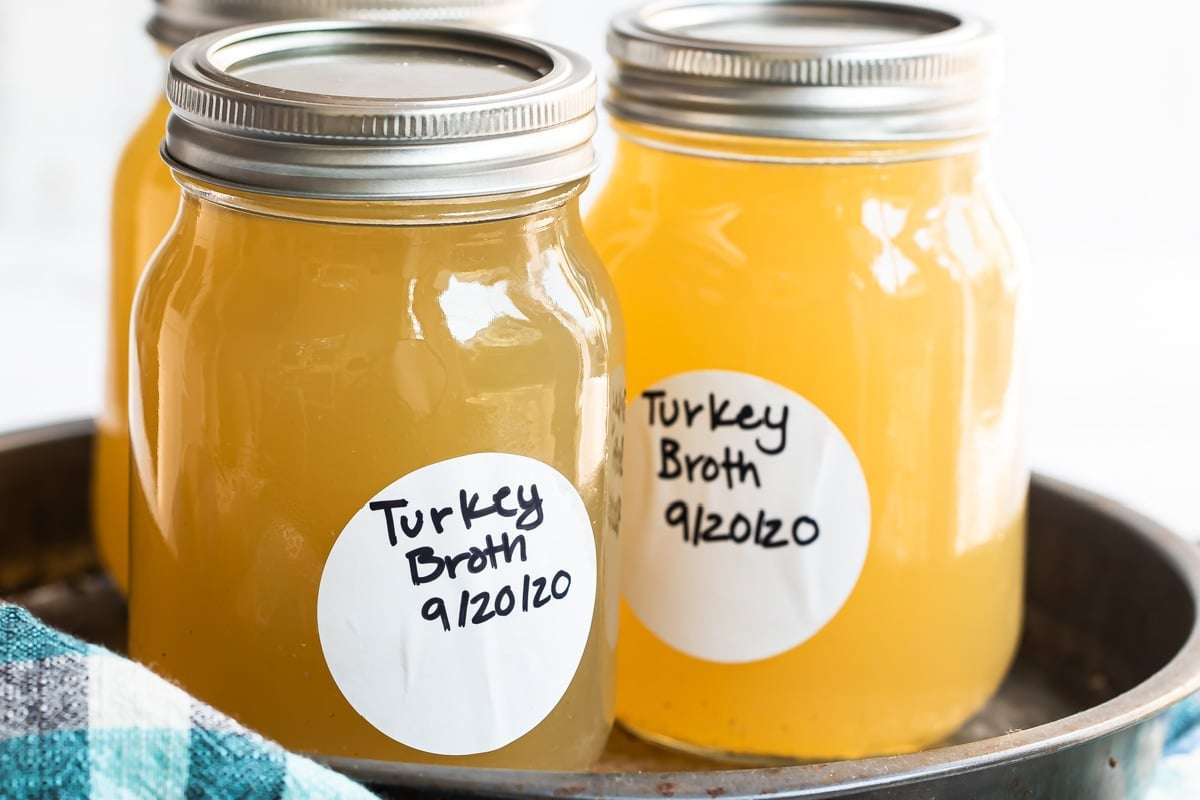
5.0 from 78 votes
How to Make Turkey Broth
After the feast, turn the leftover turkey carcass into a rich, flavorful broth using some simple vegetables and herbs. You'll have about 2 quarts of homemade turkey broth, perfect for freezing or making soup.
Prep Time
10 mins
Cook Time
1 hr 10 mins
Total Time
1 hr 40 mins
Servings: 8 cups
Calories: 13 kcal
Course:
Soup
Cuisine:
French
Ingredients
- 1 roasted turkey carcass cut into pieces (see note 1 & 2)
- cold water about 12 cups (see note 3)
- 1 medium onion peeled and halved
- 1 large carrot peeled and coarsely chopped (see note 4)
- 1 celery rib coarsely chopped
- 1 tablespoon salt
Sachet (see note 5):
- 6 fresh parsley stems
- 1 prig fresh thyme
- 2 cloves garlic
- 1 bay leaf
- 1 teaspoon whole black peppercorns
Instructions
- To a Dutch oven or large stock pot, add turkey carcass and enough cold water to cover it (see note 2).
- Over medium-high heat, bring to a boil. Immediately reduce heat to low and skim the foam off the top.
- To the pot add onion, carrot, celery, and salt. If desired, tie parsley stems, thyme, garlic, bay leaf, and peppercorns to make a sachet or add loosely to the pot (see note 5).
- Simmer gently (bubbles should barely break the surface at irregular intervals) until the turkey has released its flavor, at least 1 hour or up to 4 hours. The longer the broth simmers, the more flavor it will have.
- Strain the broth through a fine-mesh strainer or cheesecloth. Place in a large bowl and chill covered overnight in the refrigerator.
- The next day, scrape off the accumulated fat from the top of the stock and discard. Divide the broth into freezer-safe containers (leaving at least 1/2-inch for expansion), label, and freeze. Or, refrigerate and use within 4 days.
Cup of Yum
Notes
- Turkey carcass: Bones and all. To help the turkey fit in a pot, cut it into 4 or 5 pieces with kitchen shears or a knife.
- Organ meats: The heart and gizzard can be added to the broth if desired, but the liver should be discarded or reserved for another purpose.
- Cold water: Always start with cold water. This helps keep the broth clear, not cloudy. The amount of water used and the length of simmering time will determine the intensity of the broth.
- Vegetables: Some cooks save old vegetable trimmings to add to their broth. I prefer to start with new, fresh vegetables because I think the broth will taste better. So yes, we peel the carrots, and save your vegetable scraps for composting!
- Herbs and spices: A sachet is a fancy term for parsley stems, thyme, bay leaves, peppercorns, and optionally, garlic or cloves, tied up in a piece of cheesecloth with twine. You could also use a tea ball or loose leaf tea bag to hold them. It makes it easier to pull these small ingredients out of the broth later. Or, you can just add everything straight to the pot since you strain the broth at the end.
- Yield: This recipe makes about 8 cups (2 quarts) turkey broth.
- Storage: Store turkey broth in the refrigerator and use within 4 days.
- Freezer: Divide the broth into freezer-safe containers (I like to use 16-ounce glass jars) and leave 1/2-inch head space for expansion. Label and date, then freeze for up to 3 months. Thaw overnight in the refrigerator.
Nutrition Information
Serving
1cup
Calories
13kcal
(1%)
Carbohydrates
3g
(1%)
Protein
1g
(2%)
Fat
1g
(2%)
Saturated Fat
1g
(5%)
Cholesterol
1mg
(0%)
Sodium
884mg
(37%)
Potassium
69mg
(2%)
Fiber
1g
(4%)
Sugar
1g
(2%)
Vitamin A
1589IU
(32%)
Vitamin C
3mg
(3%)
Calcium
12mg
(1%)
Iron
1mg
(6%)
Nutrition Facts
Serving: 8cups
Amount Per Serving
Calories 13
% Daily Value*
| Serving | 1cup | |
| Calories | 13kcal | 1% |
| Carbohydrates | 3g | 1% |
| Protein | 1g | 2% |
| Fat | 1g | 2% |
| Saturated Fat | 1g | 5% |
| Cholesterol | 1mg | 0% |
| Sodium | 884mg | 37% |
| Potassium | 69mg | 1% |
| Fiber | 1g | 4% |
| Sugar | 1g | 2% |
| Vitamin A | 1589IU | 32% |
| Vitamin C | 3mg | 3% |
| Calcium | 12mg | 1% |
| Iron | 1mg | 6% |
* Percent Daily Values are based on a 2,000 calorie diet.